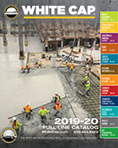One World Trade Center: Restoring Confidence
Facing A Monumental Challenge
![]() Removing Very Special Debris
Removing Very Special Debris
Avoiding The Hudson’s Ooze
The site itself posed an extraordinary engineering problem to solve. For countless years, it had been a busy, working landfill that had eventually expanded the land area of lower Manhattan into the Hudson River. Without creating some type of barrier, the river’s waters would ooze the excavation as quickly as the compacted material was pulled from the ground.
The answer was nearly Medieval in nature. In effect, a deep moat (or trench) surrounding the site was dug and filled with a mixture of water and a high-swelling pond clay called bentonite. The result worked because dirt was not as dense as the slurry, and that kept the threat of a cave-in at bay.
Clearing The Path To Bedrock

Making Safe and Strong Beautiful

Curbing The Risk Of Falling Objects
During construction, as the tower began to rise above its neighbors in the Manhattan skyline, contractors had to consider ways of minimizing the risk of objects falling from height. With all the pedestrian traffic that New York City is known for, this was no small concern.
![]() Developing A Super Concrete
Developing A Super Concrete
Taking Steps To Improve Safety

Engineering Exterior Eye Candy

The extremely high U-value of the glass keeps interior spaces comfortable (contributing to its gold LEED rating) and its high transparency makes gazing across the landscape below a special treat. On the outside, the highly-reflective glass, with its corners covered in laser-finished stainless steel creates a breathtaking daily display. And when the light is just right, you can even see straight through it.
Restoring A Country’s Confidence
After the original Trade Towers fell on that terrible day, there was no shortage of voices calling for the goal of rebuilding on the same site to show terrorists our collective resolve and restore the confidence of the American people. But an unstated goal was standing by quietly in the shadows.
Architects, engineers and contractors wanted to restore Americans’ confidence in the viability and safety of skyscrapers. After painstakingly analyzing safety issues and what had happened structurally during the tragic event, the builders of One World Trade Center constructed a tower that has rewritten the playbook for supertall buildings to come.

 Removing Very Special Debris
Removing Very Special Debris
 Developing A Super Concrete
Developing A Super Concrete


Cool article HD Supply – White Cap!
Thanks Greg! Glad you enjoyed it.
Uh,the USS New York is Not an aircraft carrier. A little research and you would have known this.
USS New York (LPD-21) is a San Antonio-class amphibious transport dock and the fifth ship of the United States Navy to be named after the state of New York.
OK, let’s go with “Amphibious Warfare Ship”
Aircraft carried:
Launch or land
two CH-53E Super Stallion
two MV-22B Osprey tiltrotor aircraft
four CH-46 Sea Knight
four AH-1 SeaCobra or
four UH-1 Iroquois helicopters.
The USS New York is an LPD, which is a different animal than a straight Aircraft Carrier.